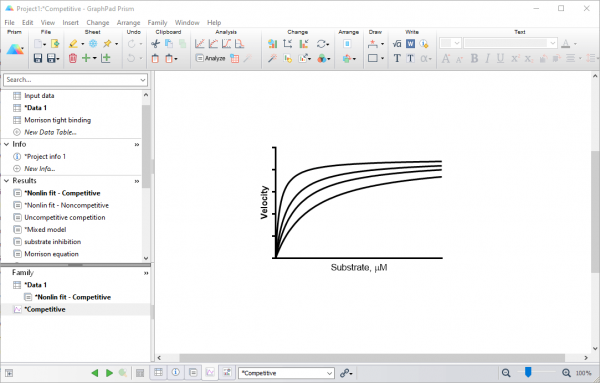OVERVIEW:
 The suggested graphing and analysis tool created especially for scientific research is DraphPad Prism Full Version. Join the world’s leading scientists and learn how to use Prism to speed up your research, make better analysis decisions, and present your findings in an elegant way.
The suggested graphing and analysis tool created especially for scientific research is DraphPad Prism Full Version. Join the world’s leading scientists and learn how to use Prism to speed up your research, make better analysis decisions, and present your findings in an elegant way.
Benefits of GraphPad Prism 10.4.0.621:
- Organize Your Data Effectively:
DraphPad Prism Latest Version is specifically designed for the kinds of analyses you want to do, like quantitative and categorical data analysis. This makes it easier to enter data accurately, choose relevant analyses, and create visually appealing graphs.
- Sample Size and Power Analysis:
DraphPad Prism Final Version entirety Either accurately estimate the sample size needed for the effect you expect, or investigate the smallest effect you can find with a small sample size, to begin your experiments as efficiently as possible. Increase the validity of your findings, safeguard valuable resources, and streamline your research process.
- Perform the Right Analysis:
Steer clear of statistical jargon. Prism provides a vast library of analyses, ranging from widely used to highly specialized, in an easy-to-understand manner. These analyses include survival analysis, principal component analysis, binary logistic regression, one-, two-, and three-way ANOVA, t tests, linear and nonlinear regression dose-response curves, and much more. Every analysis comes with a checklist to help you make sure you’ve chosen the right test and comprehend the necessary statistical assumptions.
- Get Actionable Help as You Go:
Reduce the complexity of the statistics. The web support offered by DraphPad Prism Pre-Activated exceeds your expectations. At almost every point, access thousands of pages from the Prism User Guides. You can access manuals, instructional videos, and other materials with Prism Academy. Explore the Graph Portfolio to see how to create various types of graphs. Additionally, tutorial data sets help you understand the reasoning behind particular analyses and how to interpret your results.
- One-Click Regression Analysis:
Prism is the only program that makes curve fitting so much easier. Once you choose an equation, Prism takes care of the rest, fitting the curve, displaying the function parameters and results in a table, graphing the curve, and interpolating unknown values.
- Focus on Your Research, Not Your Software:
Prism can handle the coding. The graphs and results are automatically updated in real time. Any changes made to the data and analyses—including direct data entry, the deletion of inaccurate data, typo corrections, and changed analysis selections—instantaneously update the results, graphs, and layouts.
- Automate Your Work Without Programming:
A single click, automatically add numerous pairwise comparisons to your analysis. To modify these lines and asterisks, just click the toolbar button once more. The results shown on the graph will automatically update if you make changes to the data or the analysis.
- Countless Ways to Customize Your Graphs:
DraphPad Prism explores different ways to display a single dataset. For your data visualization, pick a visual style that best tells the story it contains. To change the data arrangement, data point style, labels, fonts, colors, and much more in real-time, simply choose the type of graph you want. Numerous customization options are available.
- Explore Your Data:
Concentrate your attention on examining the most pertinent data. Tailor the way you display the connections within the data to efficiently examine sizable datasets. Have you noticed anything intriguing? To investigate the properties that correspond to a particular data point, highlight it. Prisms’ extensive data wrangling features allow you to guarantee that your analysis is founded on clean, well-structured data while also saving time.
- Export Publication-Quality Graphs With One Click:
Cut down on the publishing time. You can modify your exports with Prism to match journal requirements in terms of file type, resolution, transparency, dimensions, and color space RGB/CMYK. Presets can help you save time.
- Collaboration Simplified:
Instead of using jumbled email threads to share, view, and collaborate on your Prism projects, use DraphPad Prism Cloud. Use Prism’s open access file format to safeguard the interoperability and reusability of your results. By using industry-standard formats (CSV, PNG, JSON, etc.), you can ensure that your projects can be utilized outside of Prism to open up new possibilities for your data workflows and integrations.
You may also like: Download Serato DJ Pro
GraphPad Prism 10.4.0.621 Key Features:
- Bubble Plots: Directly from the raw data, create Bubble Plots by encoding the position (X and Y coordinates), color, and size variables.
- Violin plots: Using violin plots that are either extended or truncated, visualize distributions of large data sets.
- Estimation Plots: Show the results of your analysis automatically
- Smoothing spline: Significant gains in the ability to display broad data trends using smoothing splines and Akima splines, with better control over the quantity of knots, or inflection points
- Stars on Graph: Add results of multiple comparisons to graphs automatically. Select from a range of P value summary styles, such as a flexible approach suitable for any alpha level.
- Improved Graph Customization: Create beautiful Bubble plots more quickly, simply, and intuitively than ever before. Real-time interaction and customization of graphs derived from your Multiple Variables data
- Automatically label bar graphs: To highlight key findings in your work, annotate your bar graphs with values for the means, medians, or sample sizes.
- Improved grouped graphs: It is simple to make graphs that display the mean (or median) and error bars in addition to individual points (scatter).
- Greater Collaboration: To prevent those disorganized email threads, use Prism Cloud. Manage all of your conversations in one location while safely limiting who can access your work.
- A More Open Access File Format: You can make sure that your projects can be used outside of Prism and create new opportunities for your data workflows and integrations by utilizing industry-standard formats (CSV, PNG, JSON, etc.).
- Expanded Data Table Capabilities: As many windows as necessary can be open at once, and data can be organized into up to 2048 columns with 512 sub columns each. The expanded analysis constant dialog lets you connect to additional analysis results of all kinds.
- Intelligent Data Wrangling: A new range of tools to help prepare your data for analysis. selecting and transforming analysis, extracting and rearranging functionality, and dealing with data tables with multiple variables
- Hook Constant Dialog Upgrade: A practical method of creating links between various Prism elements. Every Prism analysis in the library is now covered by a new, user-friendly tree structure.
- XY tables: Utilized when each data point has a single X and Y value that defines it. Regression models, either linear or nonlinear, are frequently used to fit this type of data.
- Column tables: Utilized when data has been grouped according to a single grouping variable (e.g., Treatment vs. Control, Female vs. Male). frequently examined with one-way ANOVA and t tests.
- Grouped tables: Utilized when data is grouped according to two grouping variables (e.g., male control vs. male treatment, female control vs. female treatment, etc.). frequently examined using a two-way ANOVA.
- Contingency tables: Classify count data based on two grouping variables: treatment versus control and positive versus negative outcome. appropriate for Chi-square analysis and Fisher’s exact test.
- Survival tables: Utilized in the Kaplan-Meier survival analysis process. A subject or individual with their elapsed survival time and outcome is represented by each row.
- Parts of whole tables: When asking “What fraction of the total is each value in the table?” makes sense, use this phrase. used to create pie charts and calculate fractions.
- Multiple variables tables: Used when the data has distinct observations for each row and distinct variables for each column that support text values. can be transformed into one of Prism’s other table types or directly analyzed using methods like Cox regression and multiple linear regression.
- Nested tables: Utilized when groupings of data are arranged hierarchically. nested one-way ANOVA or nested t tests were used for the analysis.
- Perform repeated measures ANOVA – even with missing data: To finish this analysis, Prism will now automatically fit a mixed effects model.
- Perform simple and multiple logistic regression: Create a model based on one predictor variable (simple logistic regression) or several predictor variables (multiple logistic regression) and fit it to a binary outcome (yes/no, win/lose, pass/fail).
- Principal Component Analysis (PCA): Determine which of the principal components best captures the variation in your data. Select from a variety of selection methods, such as Eigenvalue threshold, Proportion of Variance threshold, Parallel Analysis via Monte Carlo simulation, and more.
- Multiple t test (and nonparametric) analyses: Concurrently run several independent two-sample comparison tests. Choose between parametric and nonparametric tests, and indicate if the data are paired or unpaired.
- Analyze categorical variables with text in Multiple Linear and Multiple Logistic Regression: No coding knowledge is necessary! Prism will carry out the analysis and automatically encode categorical variables. For results that are readable and understandable, include a reference and arrange all tiers of categorical variables in a model.
- Interpolation from multiple linear and multiple logistic regression: Using the data in the data table or the theoretical values given in the analysis, use the designated model to forecast values for the dependent variable.
Statistical Comparisons:
- T-tests, whether paired or not. provides confidence intervals and P values.
- Produce a volcano plot (difference versus P value) automatically based on the analysis of multiple t tests.
- Mann-Whitney test that is nonparametric and includes the confidence interval for the median difference.
- To compare two groups, use the Kolmogorov-Smirnov test.
- Wilcoxon test using a median confidence interval.
- Run numerous t tests simultaneously, selecting which comparisons are discoveries for additional research based on the False Discovery Rate (also known as Bonferroni multiple comparisons). The Tukey, Newman-Keuls, Dunnett, Bonferroni, or Holm-Sidak multiple comparison tests, the post-test for trend, or Fisher’s Least Significant tests are performed after an ordinary or repeated measures ANOVA.
- Brown-Forsythe and Welch one-way ANOVAs without assuming populations with equal standard deviations, followed by the relevant comparison tests (Games-Howell, Tamhane T2, Dunnett T3)
- P values that have been multiplicity adjusted and confidence intervals accompany many multiple comparison tests.
- Greenhouse-Geisser correction, which eliminates the need to assume sphericity in one-, two-, and three-way ANOVAs for repeated measures. Additionally, multiple comparison tests do not assume sphericity when this is selected.
- Use the Friedman or Kruskal-Wallis nonparametric one-way ANOVA along with Dunn’s posttest.
- The chi-square test or Fisher’s exact test. Determine the odds ratio and relative risk using confidence intervals.
- Two-way ANOVA, even in cases where certain post-tests have missing values.
- repeated measures in one or both factors in a two-way ANOVA.
- Main and simple effects are tested using multiple comparisons using Tukey, Newman-Keuls, Dunnett, Bonferroni, Holm-Sidak, or Fisher’s LSD.
- ANOVA in three dimensions, with two levels allowed for two factors and an unlimited number of levels for the third.
- Analysis of one-, two-, and three-way repeated measures data using a mixed effects model—a repeated measures ANOVA-like technique that can account for missing data.
- Data from nested data tables are compared using a mixed effects model-based nested one-way ANOVA or a nested t test.
Nonlinear Regression:
- Either enter your own equation or use one of our 105 pre-built ones. Including the exponential growth, exponential plateau, logistic, Gompertz, and beta growth and decay equations now.
- Add implicit or differential equations.
- For each set of data, enter a different equation.
- Parameters for global nonlinear regression are shared across data sets.
- robust regression without linearity.
- Automatic detection or removal of outliers.
- Use the extra sum-of-squares F test or AICc to compare the models.
- Analyze parameters between datasets.
- Put limits in place.
- Differentially weight the points using multiple techniques, then evaluate the effectiveness of your weighting strategy.
- You can enter your own initial estimates or accept the automatic ones.
- Automatically create a graph curve within a given X value range.
- Calculate the precision of the fits using the parameter’s SE or CI. Confidence intervals can be either asymmetrical, which is more accurate, or symmetrical, as is customary.
- Calculate the imprecision’s symmetry using Hougaard’s skewness.
- Plot prediction or confidence bands.
- Verify the residuals’ normalcy.
- Carries out or duplicates the model’s adequacy test.
- Provide the dependencies or covariance matrix.
- Interpolating points from the best fit curve is simple.
- Determine the intersection point and both slopes of two data sets by fitting straight lines to them.
Survival Analysis:
- Kaplan-Meier survival analysis. Perform nonparametric survival analysis for different groups and compare the estimated survival curves for each group using the log-rank test (including the trend test).
- Cox proportional hazards regression. To add covariates, or more continuous or categorical predictor variables, perform a semi-parametric survival analysis. Make estimated survival graphs.
Principal Component Analysis:
- Selection of components using the Kaiser criterion (Eigenvalue threshold), the Proportion of Variance threshold, Parallel Analysis (Monte Carlo simulation), and other methods.
- Scree plots, loading plots, biplots, and other graphics produced automatically.
- Utilize the outcomes in subsequent processes such as Principal Component Analysis.
Multiple Variable Graphing:
- Indicate the variables that define the color, size, and axis coordinates.
- Make Bubble Plots.
Column Statistics:
- Compute the following descriptive statistics: mean, SD, skewness, kurtosis, CI, CV, min, max, quartiles, and SEM.
- Mean or geometric mean along with the range of confidence.
- Frequency distributions, including cumulative histograms, from bin to histogram
- Four approaches for testing normalcy (new: Anderson-Darling).
- Probability of sampling from a normal (Gaussian) vs. lognormal distribution and the lognormality test
- As a component of the normalcy test, create a QQ plot.
- To compare the column, mean (or median) with a theoretical value, use a single sample t test or a Wilcoxon test.
- Use the ROUT or Grubbs method to find outliers.
- Using the FDR method or Bonferroni multiple comparisons, analyze a stack of P values to find “significant” findings or discoveries.
Simple Linear Regression and Correlation:
- Determine the intercept and slope using confidence intervals.
- Push the regression line through a predetermined intersection.
- Fit to mean Y or replicate Y values.
- A runs test can be used to check for deviations from linearity.
- Compute residuals and plot them using four different methods (including the QQ plot).
- Examine the intercepts and slopes of two or more regression lines.
- New points should be interpolated along the standard curve.
- Nonparametric correlation, such as Pearson or Spearman.
Generalized Linear Models (GLMs)
- Using the newly created multiple variables data table, create models that relate several independent
- Variables to a single dependent variable.
- When Y is continuous, multiple linear regression is used.
- Poisson regression (when Y is counts; 0, 1, 2, …).
- When Y is binary—yes/no, pass/fail, etc.—logistic regression is used.
Diagnostic (Clinical) Laboratory Statistics
- Plots of Bland and Altman.
- Curves of receiver operator characteristic (ROC).
- Deming regression, also known as type Ill linear regression.
Simulations:
- Run XY, Column, or Contingency table simulations.
- Monte-Carlo analysis of repeated simulations of data.
- Plot functions using selected or entered equations with user-specified parameter values.
Other Calculations:
- Confidence interval and area under the curve.
- Change data.
- Establish normalcy.
- Determine the outliers.
- Tests for normalcy.
- Flip the tables.
- Baseline subtracted (columns combined).
- Calculate each value as a percentage of the row, column, or overall sum.
GraphPad Prism 10.4.0.621 Changelog:
(Released on 29-10-2024)
New Features:
- Introduced two new Gaddum-Schild equations (with a fixed SchildSlope parameter) for nonlinear regression.
- Prism integration with Luma (Lab Connect).
Feature Improvements:
- Updated the results reported by existing Gaddum-Schild equations (with variable SchildSlope parameter) for nonlinear regression.
- Improved the “Regularly spaced ticks” options in the Format Axes dialog to be more intuitive for heat maps built from multiple variables tables.
- Enabled the “Number format” dropdown in the “Regularly spaced ticks” section of the “Format Axes” dialog for heat maps built from multiple variables tables.
- Improved discoverability of axis formatting options for heat maps by adding a link to the Format Axes dialog from the labels tab of the Heat Map GDO in the Format Graph dialog.
- Added the “Color for non-numeric values” checkbox to the “Fill and Border” sub-tab of the “Data” tab of the Graph Inspector for heat maps.
- Improved the file auto-recovery feature so that Prism can open files with corrupted links to analysis constants.
- Added the titles to the color and transparency controls in the Graph Inspector to remove ambiguity about “transparency” vs “opacity”.
- Improved reporting of equality of variance tests such that Prism will now report results with as few as two data points in each group.
- (Mac) Made it more clear how to re-define inappropriate data chosen to build a multiple variables graph by making the “Axis Variables” text in the hint that is shown in the “Format Graph” dialog as a link to the “Axis Variables” tab of the dialog.
- (Mac) Enabled options to format symbols, connecting lines/curves and bars/droplines/spikes in the Format Graph dialog for graphs generated by the Normalize analysis.
- (Mac) Enabled symbol formatting controls in the Format Graph dialog for XY graphs generated from green results sheets where the X column was a series of values.
- (Mac) Improved the behavior of selecting graphs in the graph gallery mode so that the checkbox on a graph preview thumbnail is checked when clicking either the checkbox itself or the checkbox title.
Performance:
- Fixed the issue in which Prism unexpectedly recalculated the results of a “child” analysis an extra time upon switching to it if the “Recalculate All” operation was previously performed from the “parent” results sheet.
- (Windows) Fixed the issue in which Prism 10.3.0-10.3.1 was slower than previous versions while switching between graph and layout sheets that contained a large number of drawing objects.
- (Windows) Fixed the issue in which a long delay was observed while opening the “Parameters: Select and Transform” dialog on an analysis containing more than five transforms.
- (Windows) Fixed the issue in which Prism would crash while importing large quantities of data.
Analysis-related Bug Fixes:
- Fixed the issue in which Prism would crash when performing the “K-means clustering analysis” from a survival data table with more than two groups.
- Fixed the issue in which values in the X column of the Curve/Line results tabs of Nonlinear and Linear regression analyses were unexpectedly altered if the same value was set as the start and end of the curve/line in the parameters dialog.
- Fixed the issue in which the “Use X values from the data table” radio button was disabled in the “Parameters: Simulate XY data” dialog if the source data table did not contain Y values.
- (Mac) Fixed the issue in which the disabled “Assume the baseline is linear with X” option was used for selected rows in the “Parameters: Remove Baseline and Column Math” dialog.
Graphing Bug Fixes:
- Fixed the issue in which “Mean with SD” was plotted instead of “Mean with SEM” on the grouped graph generated for the Extract and Rearrange analysis if the SEM error bar style was selected as the default in Prism’s preferences.
- Fixed the issue in which a graph generated by the Transform concentrations (X) analysis disappeared after recalculation.
- Fixed the issue when major and minor grid lines unexpectedly appeared overlapping the symbols of a multiple variables graph.
- Fixed the issue when the Magic feature did not apply symbol color and transparency formatting on multiple variables graphs.
- Fixed the issue when the Y-axis numbering was cut on the XY graph copied to the layout sheet if Y ticks were turned off and the numbering font size was large.
- Fixed the issue when multiple variable heat maps displayed data using deleted metric variables from the data table.
- Fixed the issue when axes labels on the multiple variables heat map graph were not updated after changing axes variables.
- Fixed the issue when the color of symbols on the multiple variables graph or cells of the multiple variables heat map graph were unexpectedly altered after applying the custom color of axes via the ‘Define Color Scheme’ dialog.
- Fixed the issue when the resizing knobs did not appear on the selected bubble plot axes without ticks.
- Fixed the issue when the width and height of the text object on the bubble plot were unexpectedly altered after rotation.
- Fixed the issue when labels of branches on a dendrogram unexpectedly changed their rotation angle from 90 to 45 degrees after switching graph orientation.
- Fixed the issue in which graphs generated by the Transform concentrations (X) analysis disappeared after recalculation for PZFX/PZF files that had been converted from .prism files.
- Fixed the issue in when the wrong region of the graph was shaded after adding custom additional ticks and selecting the option “Fill (shade) between this tick and Y=” in the “Format Additional Ticks and Grids” dialog.
- Fixed the issue when the scale bar did not appear for multiple variables graphs after hiding both the X and Y axes and enabling the scale bar option on the “Format Axes” dialog.
- (Windows) Fixed the issue when a color added in the “Custom Color” section of the Choose Color dialog was lost after saving a project.
- (Windows) Fixed the issue when adding tabulation symbols corrupted free text objects on a graph.
- (Windows) Fixed the issue when data legends on a graph were unexpectedly altered when a graph was copied to MS Office if legends had been hooked to analysis constants.
- (Windows) Fixed the issue when graph titles of a set of graphs of the same size and scale assigned to the layout unexpectedly appeared unaligned vertically.
- (Windows) Fixed the issue when it was impossible to change the fill color of bars on the Scatter graph with bars from the contextual menu on the graph.
- (Windows) Fixed the issue when just one Prism graph appeared instead of an entire layout copied from Prism to MS Word as a linked (OLE) object.
- (Windows) Fixed the issue when the color set for error bars in the Format Graph dialog for the ‘Column mean, error bars & mean connected’ graph was not applied.
- (Windows) Fixed the issue when arrowheads added to arcs drawn on multiple variables graphs were truncated.
- (Mac) Fixed the issue when a page orientation of a multiple variables graph could be unexpectedly changed by using the ‘Page Setup’ dialog.
- (Mac) Fixed the issue when filling patterns of drawing objects on a graph were incorrectly rendered (appeared upside down).
- (Mac) Fixed the issue when images imported to a graph were distorted after saving a project in legacy .pzfx/.pzf format.
- (Mac) Fixed the issue when the appearance of the ‘step-up’ type survival graph unexpectedly changed to the ‘step-down’ type if the Y axis title was changed.
- (Mac) Fixed the issue when the distance for the X-axis title from the axis unexpectedly changed after changing the default X-axis title for XY graphs.
- (Mac) Fixed the issue when the transparency value defined for the bubble symbol fill color in the Format Graph dialog did not update accordingly while scrolling through the variable groups.
- (Mac) Fixed the issue when the Y-axis title lost its center justification after updating the “Distance from axis” option in the Format Graph dialog.
- (Mac) Fixed the issue when the tooltip with coordinates was shown when dragging an object on a graph or layout if the ‘Show tooltips’ preferences option was turned off.
- (Mac) Fixed the issue when row and column titles were not updated in the embedded data table on the multiple variables graph after changing them in the data table.
- (Mac) Fixed the issue when ‘Compact Letter Display’ labels from another analysis performed on the same data table were not displayed on the graph.
- (Mac) Fixed the issue when angled fill patterns of drawing objects appeared with wrong angles on multiple variables graph sheets.
- (Mac) Fixed the issue when unexpected grids appeared on the ‘angled brick’ fill pattern set for drawing objects on multiple variables graph sheet.
- (Mac) Fixed the issue when the dendrogram’s orientation was unexpectedly changed to the opposite of the one selected in the ‘Format graph’ dialog after switching between the Graph Inspector’s tabs.
- (Mac) Fixed the issue when closed drawings on a graph unexpectedly appeared with borders even though the borders were disabled in the ‘Shapes’ tab of the Graph Inspector.
- (Mac) Fixed the issue when the border thickness of the gradient legend on a multiple variables graph was not updated after redefining it in the ‘Gradient Legend Settings’ dialog.
- (Mac) Fixed the issue when the axis label type of the multiple variables heat map graph was not updated on the Data tab of the Graph Inspector after changing it on the Axes tab in the Inspector or in the ‘Format Graph’ dialog.
- (Mac) Fixed the issue when data from the final data set of a table was not plotted on a scatter graph with a huge number of points after increasing the default size of the X axis.
Prism Cloud-related Bug Fixes:
- Fixed the issue when unnecessary thin white lines between cells were present on multiple variables heat maps published to Prism Cloud.
- (Windows) Fixed the issue when the project was not auto-saved while performing the ‘Publish’ or ‘Update’ commands while sending the file to Prism Cloud.
- (Windows) Fixed the issue when the ‘Publish’ button was enabled for an unsaved project if the clustering sample data was included.
- (Windows) Fixed the issue when dash-dotted borders of confidence ellipses and convex hulls were shown as solid lines on the graphs published to Prism Cloud.
- (Mac) Fixed the issue when the Color legend of the multiple variables heat map published to Prism Cloud appeared blank if some values in the data table were missing or excluded.
- (Mac) Fixed the issue when an altered but not re-saved Prism project was missing the data table, info, and results sheets after publishing to Prism Cloud.
Other Bug Fixes:
- Fixed the crash that occurred when opening a Prism project with Select and Transform analysis if an empty column was previously added or deleted in the source multiple variables data table with categorical variables.
- Fixed the crash that occurred when clicking the OK button in the ‘Parameters: Select and Transform’ dialog if a long text was entered in the ‘Transform’ field of the ‘Custom transforms’ section.
- Fixed the issue when it was possible to exceed the sheet count limit in the Prism project by performing analyses that generated graphs.
- Fixed the issue when the ‘Disk or memory error occurred’ alert appeared on switching to the results sheet of the Multiple linear regression analysis if the source data table contained the multiline column titles.
- Fixed the crash that occurred when undoing axes reassignment for multiple variable heat maps.
- Fixed the issue when the ‘Change Graph Type’ and ‘Format Axes’ toolbar icons unexpectedly remained active after the standalone Dendrogram was toggled off.
- Fixed the issue when files and folders related to the ‘child’ analysis unexpectedly disappeared from the .prism file bundle after the ‘Recalculate All’ operation was performed from the ‘parent’ results sheet.
- Fixed the issue when a hint that Dendrogram could not be added unexpectedly appeared in the ‘Format Graph’ dialog if the ‘Show Dendrogram’ option was unchecked in the ‘Format Graph’ dialog before saving the file.
- Fixed the issue when ‘The following data objects cannot be displayed…’ floating note on an empty graph listed all data objects instead of the currently enabled ones due to incompatible axes.
- Fixed the crash that would occur when using Hierarchical clustering as a saved method with non-multiple variables data.
- Fixed the issue when a graph generated by the Transform concentrations (X) analysis disappeared after recalculation in PZFX/PZF files converted from .prism file format.
- Fixed the crash that would occur when hiding the X or Y axis on a multiple variables graph after the previous operation of hiding the axis was undone.
- Fixed the issue when controls for the dendrogram were unexpectedly enabled in the “Format Graph” dialog after using the Magic tool.
- Updated the hint on the “Account” tab of the Prism Settings dialog to manage the details of Prism license and linked accounts.
- (Windows) Fixed the crash on an attempt to edit a huge (more than a thousand characters) text object on a graph or layout sheet.
- (Windows) Fixed the freeze and added the progress bar when deleting many sheets from the project.
- (Windows) Fixed the crash that occurred upon opening the ‘Parameters: Simple Logistic Regression’ dialog with parameters linked to analysis constants.
- (Windows) Fixed the freeze or crash that occurred upon switching between sheets or changing analysis parameters if Windows had low free disk space.
- (Windows) Fixed the issue when values disappeared from the data table in the automatically saved version of the project after changes were made in the 101-th (or next) rows/columns.
- (Windows) Fixed the issue when changes to the Prism script were not saved within the current .prism file.
- (Windows) Fixed the issue when Prism was unable to open a project with an analysis that contains a constant from another analysis.
- (Windows) Fixed the issue when an updated data table title was not automatically propagated to a linked result sheet title.
- (Windows) Fixed the issue when an unexpected alert about an expired legacy (serial number) license appeared after a user-based license was successfully activated.
- (Windows) Fixed the issue when misleading row and Y values appeared in a tooltip for data on the grouped graph after adding an empty row in the source data table.
- (Windows) Fixed the issue when the sheet name and title of graphs created from results of the ‘Extract and rearrange’ analysis did not update after the response variable was changed in the analysis parameters dialog.
- (Windows) Fixed the issue when the title of a chained results sheet was not automatically updated according to changing the response variable in the ‘Extract and Rearrange’ analysis.
- (Windows) Fixed the issue when the title of the linked results sheet was not automatically updated after renaming the source data table if it was created by a ‘Duplicate family’ action with renaming.
- (Windows) Fixed the issue when the Y value was shown on the tooltip for the scatter graph with bars instead of the mean of the current data set.
- (Windows) Fixed the issue when X-axis labels were unexpectedly shifted on a printed graph when the display scale in the system settings was set bigger than 100%.
- (Windows) Fixed the issue when the order of the ‘Confidence Ellipses’ and ‘Convex Hulls’ sections in the Graph Inspector was unexpectedly changed depending on the order of selecting them in the ‘Format Graph’ dialog.
- (Windows) Fixed the issue when the ‘Clear’ option in the color palette appeared unexpectedly disabled if it was invoked from the contextual menu for the dendrogram graph.
- (Windows) Fixed the issue when the double ‘&’ symbol appeared in sheet.json files in the Prism file bundle for ‘Bias & agreement’ and ‘Sensitivity & Specificity’ results tabs of ‘Bland-Altman’ and ‘ROC Curve’ analyses.
- (Windows) Fixed the issue when no controls for the dendrogram on the heat map appeared on the Legends tab of the Graph Inspector opened by clicking the color legend.
- (Windows) Fixed the issue when it was impossible to hook constant to a column mean value in the ‘Parameters: Simulate Column Data’ dialog.
- (Windows) Fixed the issue when the multiple variables graph page was unexpectedly scrolled to the center after closing the ‘Format Graph’ dialog.
- (Windows) Fixed the issue when “Fill Color”, “Fill Pattern”, “Border Color”, and “Border Thickness” were not available in the contextual menu invoked for the bar on the ‘Scatter plot with bars’ graph type.
- (Windows) Fixed the issue when the ‘Row titles’ option unexpectedly appeared in the ‘Labels Type’ dropdown on the Data tab of the Inspector after changing the Dendrogram orientation.
- (Windows) Fixed the issue when graph previews in the ‘Graph Portfolio’ section of the Welcome dialog were not shown if the ‘EBWebView’ folder in the user’s AppData folder had read-only permissions.
- (Windows) Fixed the crash that would occur when inserting an analysis constant from the “Identify outliers” analysis on a graph.
- (Windows) Fixed the issue when the “Major ticks interval” field was being truncated in the “Format Axes” dialog.
- (Windows) Removed the Prism license expiration warning that unexpectedly appeared when clicking on embedded/linked Prism graphs in Microsoft Office documents.
- (Windows) Fixed the issue when the alert “This file was damaged or truncated” unexpectedly appeared in an attempt to delete a results sheet from the Family section of the Navigator.
- (Windows) Disabled the “Reverse Size Legend” command in the contextual menu for the color legend of a multiple variables heat map.
- (Mac) Fixed the issue in which Prism would freeze when attempting to format points on a graph from a data table with big data (over 150 000 values).
- (Mac) Fixed the crash that occurred upon undoing or redoing the ‘Duplicate Family’ command repeatedly.
- (Mac) Fixed the crash that occurred upon undoing changes made in the ‘Clusters appearance’ dropdown on the Data tab of the Graph Inspector for a Dendrogram.
- (Mac) Fixed the crash that occurred upon applying the color scheme for the multiple variables heat map after changing the assignment for X and Y axis variables from categorical to Column/Rows.
- (Mac) Fixed the issue when example graphs appeared empty after applying the Magic tool with disabled properties ‘Graph origin and appearance” and ‘Range ticks of the axis’.
- (Mac) Fixed the issue when previous column titles instead of renamed ones were used in the names of graph sheets in the Navigator that were generated from the green results sheet.
- (Mac) Fixed the issue when the custom cell border style on multiple variables heat maps were lost upon saving the file resulting in the cell border being unexpectedly displayed as a solid line in the Graph Inspector and ‘Format Graph’ dialog.
- (Mac) Fixed the issue when an unnecessary confirmation alert appeared when changing variable type directly in the multiple variable data table.
- (Mac) Fixed the issue when the values set for the border thickness of the multiple variables graph gradient legend did not match in the Graph Inspector and the ‘Gradient Legend Settings’ dialog.
- (Mac) Fixed the issue when the Transparency value set for symbols in the Graph Inspector was not updating automatically when using the transparency slider.
- (Mac) Fixed the issue when the border thickness of the continuous color legend did not match in the UI of the Graph Inspector and the ‘Format graph’ dialog.
- (Mac) Fixed the issue when a file path or file name constants hooked to the graph or layout sheet were not updated after altering.
- (Mac) Fixed the issue when the thickness of the line/arc/zigzag or borders of the closed drawings on the multiple variables graph sheets did not change according to the Graph Inspector and the contextual menu settings.
- (Mac) Fixed the issue when values pasted as linked data to the Multiple variables data tables were not updated after excluding these values in the source data table.
- (Mac) Fixed the issue with the new macOS 15 system window arrangement feature “Move and Resize” in Prism.
- (Mac) [macOS 15] Fixed the issue when it was impossible to preview Prism documents in the Finder app.
- (Mac) Fixed the issue when sheets appeared in random order in the Navigator panel after undoing the “duplicate family” action.
- (Mac) Fixed the crash that occurred when scrolling through the graph section in gallery view mode with many multiple variables heat maps.
- (Mac) Removed the “Paste A Graph from Another Project As” option from the “File & Printer” tab of Prism’s preferences.
Screenshot:


How install & activate?
- Disconnect from the internet (Recommended by FullSofts).
- Extract and install GraphPad Prism 10.4.0.621 by using setup.
- After the installation, don’t the program or exit if running.
- Copy the Fix file to the installation directory and replace it.
- It’s done, Enjoy GraphPad Prism 10.4.0.621 Full Version.









